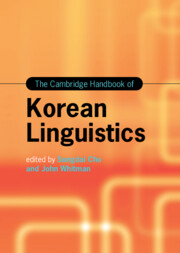Book contents
- The Cambridge Handbook of Korean Linguistics
- Cambridge Handbooks in Language and Linguistics
- The Cambridge Handbook of Korean Linguistics
- Copyright page
- Contents
- Figures
- Tables
- Contributors
- Preface
- Acknowledgments
- Abbreviations
- Part I Korean Overview
- Part II Phonetics and Phonology
- Part III Morphology and Syntax
- Part IV Semantics and Pragmatics
- Chapter 17 Subjectivity and Intersubjectivity in Korean Grammar
- Chapter 18 Discourse Studies in Korean
- Chapter 19 Metaphoric and Metonymic Patterns with the Body-Part Term Nwun “Eye(s)” in Korean
- Chapter 20 Wh-Indefinites
- Chapter 21 “Expletive” Negation in Korean
- Chapter 22 Case Stacking in Korean: Argument Structure or Information Structure?
- Part V Sociolinguistics and Psycholinguistics
- Part VI Language Pedagogy
- Index
- References
Chapter 21 - “Expletive” Negation in Korean
from Part IV - Semantics and Pragmatics
Published online by Cambridge University Press: 30 September 2022
- The Cambridge Handbook of Korean Linguistics
- Cambridge Handbooks in Language and Linguistics
- The Cambridge Handbook of Korean Linguistics
- Copyright page
- Contents
- Figures
- Tables
- Contributors
- Preface
- Acknowledgments
- Abbreviations
- Part I Korean Overview
- Part II Phonetics and Phonology
- Part III Morphology and Syntax
- Part IV Semantics and Pragmatics
- Chapter 17 Subjectivity and Intersubjectivity in Korean Grammar
- Chapter 18 Discourse Studies in Korean
- Chapter 19 Metaphoric and Metonymic Patterns with the Body-Part Term Nwun “Eye(s)” in Korean
- Chapter 20 Wh-Indefinites
- Chapter 21 “Expletive” Negation in Korean
- Chapter 22 Case Stacking in Korean: Argument Structure or Information Structure?
- Part V Sociolinguistics and Psycholinguistics
- Part VI Language Pedagogy
- Index
- References
Summary
Chapter 21 provides a unified analysis of the phenomena known as expletive negation (EN), focusing on Korean data. Contrary to the traditional term “expletive negation”, the chapter proposes that the particular type of negation in a variety of contexts has semantic content that can be analyzed on two dimensions: (i) in terms of licensing, there is a crucial semantic dependency on nonveridicality, involving, e.g., polarity items; (ii) in terms of semantico-pragmatic factors, the crucial and evaluative sense of undesirability or unlikelihood, comparable to uses of subjunctive mood in some languages. The chapter shows that expletive negation in Korean (and Japanese) occurs in typical subjunctive contexts such as polite requests, emphatic sentences, dubitatives, and also shows how the nonveridical semantics of the predicates that select EN can be represented. It proposes that these evaluative contents of EN, modifying the whole utterance, can be captured by the conventional implicature (CI) logic in the sense of Potts (2005). This has the important implication that various subspecies of EN in language are indeed part of grammar.
Keywords
- Type
- Chapter
- Information
- The Cambridge Handbook of Korean Linguistics , pp. 607 - 634Publisher: Cambridge University PressPrint publication year: 2022



